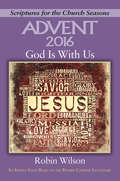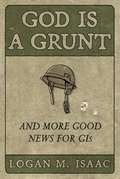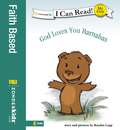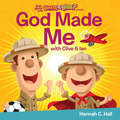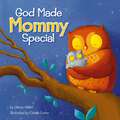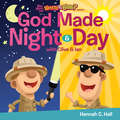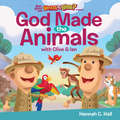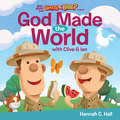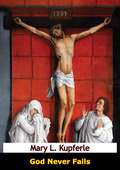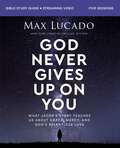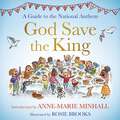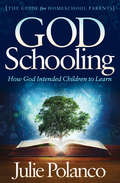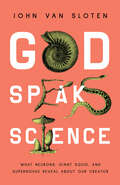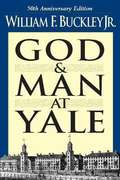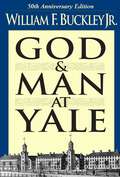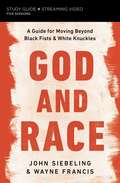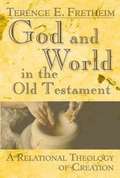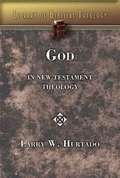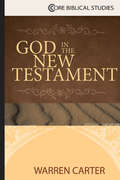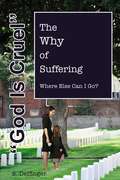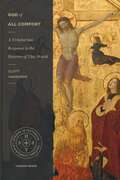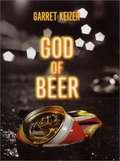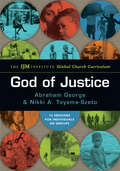- Table View
- List View
God Is With Us: An Advent Study Based on the Revised Common Lectionary (Scriptures for the Church Seasons)
by Robin WilsonMake this year's Advent even more special than usual. Prepare your heart and life for the celebration of God's presence in this season of waiting with God Is With Us, a study of the lectionary Bible readings for Advent and Christmas. By following the lectionary, your study of the Bible and your prayers will be in tune with your pastor's sermon. You'll have a better understanding of the flow of the Scripture readings chosen for the season. Be ready to claim and celebrate the new hope we have in Jesus Christ!God Is With Us is based on the Revised Common Lectionary scriptures for church Year A, the first of a three-year cycle of Bible readings. The study includes commentary and reflection on readings from the Old Testament, the Epistles, and the Gospels. It offers the opportunity to explore these Bible readings in a five-session study.
God Is a Grunt: And More Good News for GIs
by Logan M IsaacThis eye-opening book invites readers of all political and denominational stripes into a more meaningful conversation and community with soldiers and veterans. If Jesus is God, then God is a grunt—the humble, hardy folk placed at the bottom of the social hierarchy who are relied on to accomplish the dirtiest, most difficult (and most thankless) work. This is good news for millions of Christian soldiers and veterans in the U.S. because they have had to make an impossible choice, with no perceivable middle ground, between patriot and pacifist. In his new book, God Is a Grunt, Logan Isaac offers an opportunity for GIs, veterans, and those close to them to read Christian traditions as a soldier would—by and through the lived experiences of military service. This well-researched, meditative guide for Christians who have served their country delves deep into the Bible, while Isaac shares his own beliefs and thoughts on the life-altering experiences of battle. He attempts to fill the void most Christians in the military feel by providing theological resources to discern a better way of discipleship for GIs, affirming the nuance and complexity of armed service and the gifts GIs extend to Christians around the world.
God Loves You Barnabas: My First (I Can Read! #My First Shared Reader)
by Royden LeppGod Loves You Barnabas!—As Barnabas Bear walks through the Brookdale Wood, he notices the special talents of all his good friends. Mr. Beaver is good at woodworking and Sara Skunk is good at soccer. Barnabas has kind words for all of them. But then he wonders if God gave him any talents. His friends help him see what makes Barnabas a very special bear. This story, packed with humor and silliness, focuses on the daily life of Barnabas Bear and his group of friends that live in the Brookdale Wood.
God Made Daddy Special
by Glenys NellistFrom Glenys Nellist, the author who brought us Love Letters from God and Snuggle Time Prayers, comes a new book about the special bond between a father and child. God Made Daddy Special is great for parents to read with their children, as the sweet, rhyming text and adorable illustrations by Estelle Corke show how any daddy is special through the eyes of a child and through the eyes of God. Whether it&’s a daddy giraffe who stretches his neck way up high into the trees, or a daddy polar bear who skates along the ice, this book shows readers all daddies are special in their own way. With a padded cover, this cute and cuddly board book is perfect for little ones and will provide endless amounts of enjoyment for both children and parents alike.
God Made Me (Buck Denver Asks... What's in the Bible?)
by Hannah C. HallI am special because God made ME.Clive helps his brother Ian learn that he is special because God made him!Featuring beloved characters Clive & Ian from the bestselling video series Buck Denver Asks...What's in the Bible? comes a new series of fun, easy-to-read board books designed just for preschoolers. Written by bestselling children's book author, Hannah Hall, this series features charming illustrations and helps parents teach their children about God's Creation and His love for them.
God Made Mommy Special
by Glenys NellistFrom Glenys Nellist, the author who brought us Love Letters from God and Snuggle Time Prayers, comes a new book about the special bond between a mother and child. God Made Mommy Special is great for parents to read with their children, as the sweet, rhyming text and adorable illustrations by Estelle Corke show how any mommy is special through the eyes of a child and through the eyes of God. Whether it&’s a mommy monkey who swings from trees, or a mommy sparrow who cuddles her little one under her wing, this book shows readers all mommies are special in their own way. With a padded cover, this cute and cuddly board book is perfect for little ones and will provide endless amounts of enjoyment for both children and parents alike.
God Made Night and Day (Buck Denver Asks... What's in the Bible?)
by Hannah C. HallThere was a moon and there was a sun and it was good!Brothers Clive & Ian go on a camping trip and discover that God made the sun and moon, darkness and light, day and night!From the bestselling video series Buck Denver Asks...What's in the Bible? comes a new series of fun, easy-to-read board books designed just for preschoolers. Written by bestselling children's book author, Hannah Hall, the series features charming illustrations and helps parents teach their children about God's Creation and His love for them.
God Made the Animals (Buck Denver Asks... What's in the Bible?)
by Hannah C. HallGigantic animals, teeny-tiny animals, soft furry animals, shiny animals that crawl-God made them all.Brothers Clive & Ian visit the zoo and discover that God created each amazing animal perfectly unique!Featuring beloved characters Clive & Ian from the bestselling video series Buck Denver Asks...What's in the Bible? comes a new series of fun, easy-to-read board books designed just for preschoolers. Written by bestselling children's book author, Hannah Hall, the series features charming illustrations and helps parents teach their children about God's Creation and His love for them.
God Made the World (Buck Denver Asks... What's in the Bible?)
by Hannah C. HallGod made the world and everything in it!Brothers Clive & Ian go on a picnic and discover that God created the whole world for us to enjoy.From the bestselling video series Buck Denver Asks...What's in the Bible? comes a new series of fun, easy-to-read board books designed just for preschoolers. Written by bestselling children's book author, Hannah Hall, the series features charming illustrations and helps parents teach their children about God's Creation and His love for them.
God Never Fails
by Mary KupferleThis inspiring book, God Never Fails, is devoted to teaching how you can make your life better by applying Christian principles.First published in 1958, it remains a classic within the Unity movement to this day.
God Never Gives Up on You Bible Study Guide plus Streaming Video: What Jacob’s Story Teaches Us About Grace, Mercy, and God’s Relentless Love
by Max LucadoGod's Grace Is Greater Than Your Biggest Setback.God enacts his perfect plan through imperfect people—including you and me!In this five-session Bible study (video streaming included), you will see how God used Jacob—the misbehaving patriarch who was strong on savvy but weak on conscience—simply because God chose to use Jacob. His story invites us to believe in a God who sticks with the unworthy until we are safely at home. God turns brokenness into blessings through his grace, mercy, and relentless love. Not just for Bible characters, but for you. God Never Gives Up on YOU.This study guide has everything you need for a full Bible study experience, including:The study guide itself—with discussion and reflection questions, video notes, and a leader's guide.An individual access code to stream all video sessions online. (You don't need to buy a DVD!)Sessions and video run times:Taking Shortcuts (15:30)Reaping What You Sow (16:00)Living with a Louse (17:00)Wrestling with God (18:00)Returning Home (16:00) Streaming video access code included. Access code subject to expiration after 12/31/2028. Code may be redeemed only by the recipient of this package. Code may not be transferred or sold separately from this package. Internet connection required. Void where prohibited, taxed, or restricted by law. Additional offer details inside.
God Save the King: A Guide to the National Anthem (Hodder Faith Young Explorers)
by Anne-Marie MinhallThe most iconic sound of the coronation will be the familiar song of our national anthem. First recorded as a prayer more than three thousand years ago and used at every coronation since 973AD, this prayer has become part of who we are as a nation.As featured recently in the Daily Telegraph, God Save the King is leading the conversation, as we ask - how well do we know our National Anthem? Should every child learn it ahead of the momentous celebration?God Save the King uses the words of our national anthem (first and last verses) and takes us on a tour of the UK, celebrating so many aspects of our wonderful culture: our creativity and sportsmanship, our NHS and frontline services, our rich agricultural and maritime heritage, our forward-looking urban regeneration alongside our rural and seaside traditions and of course our unrivalled ability to queue! Introduced by Classic FM's Anne-Marie Minhall, packed with fun historical facts and illustrated with fantastic detail and storytelling in each spread, God Save the King will be the perfect accompaniment to the nation's coronation celebrations and for those wanting to know more about our most famous song.
God Schooling: How God Intended Children to Learn
by Julie PolancoThis practical guide to Christian homeschooling addresses child development, education methods, and God&’s Word on the subject. The prospect of taking on full responsibility for your child&’s education can seem daunting. But with a little advice, some preparation, and knowledge of what God says in His Word about it, the rewards can vastly outweigh the challenges. God Schooling guides readers through both secular and Christian thought on child development and education methods, as well as Bible references that show us how God wants our children to be raised and educated. Homeschooling parent Julie Polanco also shares her own stories and advice based on nearly fifteen years of homeschooling her own children.
God Speaks Science: What Neurons, Giant Squid, and Supernovae Reveal About Our Creator
by John Van SlotenA joy-filled expedition into experiencing God&’s majestic, everywhere presence.DNA, the Danube River, and deep-sea life. Knees and trees. The Swiss Alps, songbirds, and supernovas. God speaks though His creation. And you don&’t have to be naturally gifted at biology, chemistry, or physics to be awakened to His wisdom and majesty. Pastor, teacher, and non-scientist John Van Sloten invites us to know God more deeply as we marvel at the complexities of His amazing creation.Knowing God through His written Word enables us to know Him more clearly through His creational Words. How does God speak through His creation, and what is He saying? Each chapter includes interviews with leading scientists and connects creation to its Creator. With the primary foundation that Jesus is the mediator of both salvation and creation, Van Sloten fields questions such as:Why are things beautiful and how can beautiful things be engaged?How does the doctrine of the Trinity teach us about the nature of tree branches and wound healing?What do the doctrines of creation, incarnation, and the resurrection tell us about phenomenon of supernovas?How do we engage God&’s providence through knees and fossils?We were made to wonder. To marvel. To know and live in awe of God. God Speaks Science expands our hearts and minds so that we might delight in the wisdom, beauty, and awesome power of our triune God!
God and Man at Yale: The Superstitions of "Academic Freedom"
by William F. Buckley Jr.In 1951, a twenty-five-year-old Yale graduate published his first book, which exposed the extraordinarily irresponsible educational attitude that prevailed at his Alma Mater. This book rocked the academic world and catapulted its young author, William F. Buckley Jr., into the public spotlight.
God and Man at Yale: The Superstitions of 'Academic Freedom'
by William F. Buckley"For God, for country, and for Yale...in that order," William F. Buckley Jr. wrote as the dedication of his monumental work-a compendium of knowledge that still resonates within the halls of the Ivy League university that tried to cover up its political and religious bias. <P><P>Buckley's harsh assessment of his alma mater divulged the reality behind the institution's wholly secular education, even within the religion department and divinity school. Unabashed, one former Yale student details the importance of Christianity and heralds the modern conservative movement in his preeminent tell-all, God and Man at Yale: The Superstitions of "Academic Freedom."
God and Race Bible Study Guide plus Streaming Video: A Guide for Moving Beyond Black Fists and White Knuckles
by John Siebeling Wayne FrancisHow you—and your church community—can play a part in ending racism. Pastors John Siebeling and Wayne Francis—whose thriving congregations are the embodiment of diversity—have pooled their insights and experiences to help others have conversations about racism. Many churches and leaders have sought their counsel, hoping to emulate their success, and yours can too.This study guide has everything you need for a full Bible study experience, including:The study guide itself—with discussion and reflection questions, video notes, and a leader's guide.An individual access code to stream all five video sessions online (you don't need to buy a DVD!).God and Race provides a non-threatening means for pastors, church leaders, and churchgoers to speak to each other about this difficult and pervasive problem. In this study, Wayne and John show how neither black fists nor white knuckles are the answer to the problem, but that what is needed are open hands, open hearts, and open minds. Together, they:Examine the White-Black tension from both perspectives.Answer all the uncomfortable questions we're afraid to ask—regarding ourselves, our families, our work and relationships, and the church.Discuss seven key statements that they believe the church needs to acknowledge today—including that racism is a real problem, that it's more than just a spiritual issue, and that the Gospel is the solution.Provide practical steps anyone can take to become part of the solution.In the Gospels, we see how the crowds came to Jesus because he talked about real issues and was not afraid to engage in the important issues of his day. In the church of today, we need to be doing the same: only by recognizing, addressing, and openly dialoguing about the racial tension in America can we begin to work toward real solutions together.Streaming video access code included. Access code subject to expiration after 12/31/2027. Code may be redeemed only by the recipient of this package. Code may not be transferred or sold separately from this package. Internet connection required. Void where prohibited, taxed, or restricted by law. Additional offer details inside.
God and World in the Old Testament: A Relational Theology of Creation
by Terence E. FretheimFretheim presents here the Old Testament view of the Creator God, the created world, and our role in creation. Beginning with "The Beginning," he demonstrates that creation is open-ended and connected. Then, from every part of the Old Testament, Fretheim explores the fullness and richness of Israel's thought regarding creation: from the dynamic created order to human sin, from judgment and environmental devastation to salvation, redemption, and a new creation.
God in New Testament Theology (Library of Biblical Theology)
by Larry W. HurtadoAnalyzes the various New Testament conceptions of God and suggests how they can best contribute to a contemporary constructive theology.In this important new volume in the Library of Biblical Theology, Larry W. Hurtado introduces the different understandings of God that arise in the books of the New Testament, and explores the ramifications of those views for contemporary theology. Questions covered include: Why has the subject of God received comparatively little attention in much contemporary New Testament scholarship? Is the Christian God of the New Testament the same deity described in the Old Testament? What impact does the New Testament's emphasis on Jesus have for its discourse about God? How do New Testament references to the Divine "Spirit" affect its understanding of God? Given the diversity of the New Testament writings, is it possible to speak of a sole New Testament view of God? How should contemporary theology understand the triadic shape of New Testament discourse about God in light of the later development of the doctrine of the Trinity?
God in the New Testament (Core Biblical Studies)
by Warren CarterAuthor Warren Carter addresses the ways in which New Testament writings present Godby asking four questions about how God relates to others: How is Godpresented in relation to Israel? How is God presented in relation toJesus and the Spirit? How is God presented in relation tobelievers/disciples/the church? How is God presented in relation to "theworld"? Carter uses these questions to help draw out the most importantfactors in each of the New Testament writings discussed."Rarelydoes one exclaim, "This is a real page-turner!" when describing a bookon the New Testament—but I must say it. With his characteristicconcision and clarity, not to mention wit and conversational style,Carter leads us on a tour of "God-at-Work" in fifteen closely-readtexts. What claims do the various texts make about God? What questionsor "red flags" do these texts raise? What effect do or should thesetexts have upon us as readers today?Carter intrepidly takes up someof the more challenging and cryptic NT texts and asks aloud many of theuncomfortable questions we’ve wondered about but might not have voicedso pointedly. He does not provide tidy answers, but his approach enticesus not to give up, but rather to dive even deeper into the texts, theirworld, and ours. In reading this book, I was variously educated,entertained, challenged, and even moved." -Jaime Clark-SolesProfessor of New Testament and Altshuler Distinguished Teaching Professor,Perkins School of Theology, Southern Methodist University, Dallas, Texas
God is Cruel: Where Else Can I Go? The Why of Suffering
by S DeffingerWhy do we question God&’s will? What do we believe about God and his relationship with us? How have others survived tragedy in their lives? Where can we go for help?
God of All Comfort: A Trinitarian Response to the Horrors of This World (Studies in Historical and Systematic Theology)
by Scott HarrowerHow does God respond to trauma in a world full of horrors? Beyond their physical and emotional toll, the horrors of this world raise difficult theological and existential questions. Where is God in the darkest moments of the human experience? Is there any hope for recovery from the trauma generated by these horrors? There are no easy answers to these questions. In God of All Comfort, Scott Harrower addresses these questions head on. Using the Gospel of Matthew as a backdrop, he argues for a Trinitarian approach to horrors, showing how God--in his triune nature--reveals himself to those who have experienced trauma. He explores the many ways God relates restoratively with humanity, showing how God's light shines through the darkness of trauma.
God of Beer
by Garret KeizerHigh school kids in Salmon Falls are much the same as high school kids anywhere else: bored. <P><P> In the far reaches of Ira County, Vermont, in the dead of winter, it seems there's nothing to do. <P>But when eighteen-year-old Kyle Nelson and a handful of friends decide to challenge the status quo with an act of civil disobedience, they discover that there's more to do than they ever bargained for. <P>Garret Keizer's gripping novel about young men and women desperate for change bears witness to the dangerous force of ideas and the searing power of friendship. <P>Here is a novel that looks truth squarely in the eye, and dares to keep on looking.
God of Earth: Finding Jesus In A Holy, Hopeful Creation
by Kristin Swenson"Wonderfully penned meditations on the basic questions Christianity - and humanity - now face" - Professor Larry Rasmussen, author of Earth Honoring Faith: Religious Ethics in a New Key. <P><P>"Informed by rich appeal to religious mystery, voiced in poetic imagery and cadence… offers thick attentiveness to the world" - Professor Walter Brueggemann, author of God, Neighbor, Empire: The Excess of Divine Fidelity and the Command of Common Good <P><P>"Seeker and visionary biblical scholar, Kristin Swenson blows past petrified Christian traditions to shine light on a profoundly radical new way to experience God" - Stephanie Pearson, contributing editor, Outside magazine. <P><P>"Calls us to heal and be healed... Fresh and poetic... opens a path for pilgrims seeking new ways of seeing and living with faith on the earth." Professor Cliff Edwards, author of Van Gogh and God: A Creative Spiritual Quest <P><P>"...Motivates and empowers readers to stretch ideas of God as they care, in love and awe, for the earth." - Reverend Pat Watkins, United Methodist Missionary for the Care of God's Creation <P><P>What happens if we imagine the Jesus of Christian theology to be realized in the nonhuman natural world around us? Basic to Christian belief is the notion that God, the creator of all, inhabited the earth in order to call to us. God of Earth embraces this central premise of Christianity - Jesus as both fully divine and fully human - and then allows for the possibility that such a Jesus need not be limited to a human man. What if Jesus were "God of earth" - not only over earth but also in and through it? As Swenson tracks that question through the cycle of a church year, she invites readers to reconsider our relationship to the nonhuman natural world and so experience new dimensions of the sacred and new possibilities for hope and healing.
God of Justice: The IJM Institute Global Church Curriculum
by Abraham GeorgeThe level of injustice in the world is staggering. The church can respond. International Justice Mission (IJM) has rescued thousands of people from oppression and violence. IJM also partners with thousands of churches to help them live out the mandate of Isaiah 1:17: to seek justice, rescue the oppressed and care for orphans and widows. Christians need to be equipped and mobilized to be the hands and feet of Jesus to those who are vulnerable and oppressed. The God of Justice is a twelve-session, discussion-based curriculum from IJM that explores the biblical narrative of justice throughout the whole of Scripture, from Genesis to Revelation. Through the participatory study of Scripture, Christians will explore God's call to engage in bringing about justice on earth. While coming to a deeper knowledge and understanding of biblical justice, participants will draw personal application for the pursuit of justice ministry in their individual lives and the wider church. Prepare to have your heart and mind engaged, to be instructed by Scripture, and to be challenged by real-life stories of people freed by the God of justice. This curriculum will help you and your church bring freedom, restoration and reconciliation to those in need. Discover how God reveals himself to those who join him on his justice journey!
